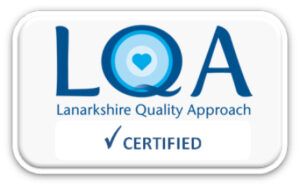Button Gastronomy
Information for patients
NHS Lanarkshire Nutrition and Dietetic Department
PIL.BUTTON.33583.L
Gastrostomy Feeding
You are currently unable to take enough food and fluid by mouth to meet your nutritional needs or you may be unable to take any food or fluids by mouth at all. The gastrostomy feeding tube will help you to meet your nutritional needs by feeding you directly into your stomach.
Gastrostomy tubes are used for longer term feeding; lasting more than four to six weeks.
Button Gastrostomy Tube
- Button gastrostomy tubes can be used to replace the initial gastrostomy tubes.
- A water filled balloon holds the tube in place in your stomach.
- The amount of water in the balloon should be checked weekly. Your district nurse will do this for you or if you prefer you or your carer may be trained to do this.
- The balloon valve will have the amount of water required written on it.
- Use cooled boiled water to fill the balloon.
- Whenever the balloon is checked or your tube is replaced it is important to check the tube is still in your stomach. This can be done by drawing out a small amount of stomach contents and testing this with pH paper. Your district nurse may do this or train you or your carer how to do this.
- A pH of 5.5 or below indicates the tube is in your stomach.
- These gastrostomy tubes require an extension set for administration of feed and medication. A new extension set should be used every two weeks.
- These gastrostomy tubes can last between three to six months.
Stop feeding and contact your Healthcare professional immediately if:
- There is pain on feeding
- External leakage of gastric contents
- Fresh bleeding
Care of Gastrostomy Tube and Stoma
Effective care of your tube and stoma are vital for your well-being. The aim is to prevent your tube blocking, maintain a healthy stoma site and to prevent infection and breakdown of the surrounding skin.
Wash your hands thoroughly before and after handling the feeding system.
- Clean your stoma with mild soap and water, rinse and dry thoroughly.
- Rotating the gastrostomy tube 360 degrees (a full turn) daily helps prevent the build up of scar tissue.
- Flush the tube regularly with cooled boiled water before and after the administration of feed to help prevent your tube blocking.
- If you give medication down your tube it must preferably be in a liquid or dispersible form, please discuss this with your pharmacist. Always remember to flush your tube before and after medication with 30 – 60 mls of cooled boiled water.
- If several medications are going down the tube, flush with 5-10mls of cooled boiled water between each one.
You should have been given a spare feeding tube, please take it with you if you have to attend hospital for a replacement. If you do not have a spare tube please let your health professional know.
- If your tube becomes blocked see troubleshooting guide.
Trouble Shooting Guide
Problem: Pain, vomiting and abdominal tenderness particularly during feeding.
Possible Cause
- Dislodged tube.
Solution
- Stop feeding immediately.
- Nil by mouth.
- Secure tube to abdominal wall and contact your Health Professional.
Problem: Tube will not flush.
Possible Cause
- Clamp still on.
- Incorrect sitting/lying position.
- Tube blocked.
Solution
- Check clamp is open.
- Change sitting/lying position.
- Try flushing tube with 60mls of warm water. If this doesn’t work, try flushing with soda water.
- Avoid using cola drinks and fruit juices.
- You can try this several times.
- Using a push/pause type of motion with the syringe you may be able to displace any debris.
- If all of the above are unsuccessful contact your feeding company nurse or health professional.
Problem: Gastrostomy tube is loose or gastrostomy tube falls out.
Possible Cause
- External fixator may have moved.
- Accidental removal
- Balloon failure
Solution
- Tighten back to original position – 2mm from skin.
- Stoma site will heal/close within two to four hours. The stoma site must be kept open if possible. If the tube is still in place do not remove it and secure in place. Arrange for tube to be replaced as soon as possible. If you have a spare tube or an Enplug this can be inserted into the stoma to prevent the stoma closing. Do not use the tube for feeding. Please contact your feeding company nurse of district nurse to confirm the tube is in the correct place before use.
- Arrange for tube to be replaced as soon as possible. Contact your health professional.
Problem: Gastro-intestinal (GI) problems such as nausea and vomiting, Diarrhoea.
Possible Cause
- Feeding regime not tolerated.
- Symptoms of underlying condition.
- Medication
- Feed not tolerated.
- Underlying condition
Solution
- Ask dietitian to review feeding regime.
- Consult GP.
- Reduce rate of feeding
- Ask GP to review medication.
- Ask dietitian to review feed.
- Consult GP.
Problem: Constipation.
Possible Cause
- Not having enough fluid.
- Not having enough dietary fibre.
- Medication
Solution
- Ask dietitian to review fluid regime.
- Ask dietitian to review feed.
- Ask GP to review medication
Problem: Gastric Reflux
Possible Cause
- Incorrect sitting/lying position.
- Feeding regime not tolerated.
Solution
- Change sitting/lying position, ensure a semi – upright position of at least 30-45 degrees.
- Ask dietitian to review feeding regime.
Problem: Redness/oozing/bleeding around the stoma site.
- Possible Cause
- Irritation due to leakage.
- Inward movement of feeding tube.
- Friction caused by clothing or fixation device.
- Infection
Solution
- Ensure the fixation device is correctly positioned. Approximately 2mm from skin surface.
- If the feeding tube has been pulled into your stomach, gently pull back out to original position. Approximately 2mm from skin surface.
- If there is any sign of irritation or infection contact District Nurse or GP for advice.
Problem: Coated (white)/lumpy tube
Possible Cause
- Fungal infection, for example, Candida.
Solution
- If there is any sign of infection contact District Nurse or GP for advice.
Instructions on using your syringe
- The syringes you have been given can be reused for up to seven days.
- Clean your syringe straight after use
- Fill a bowl with hot soapy water
- Clean the end of the syringe by drawing the water in and out through the syringe until all traces of food or medicine are removed from the tip.
- Separate the two parts of the syringe and wash them.
- Then rinse them in water under the cold tap.
- Shake off the excess water and dry with a clean paper towel. Tapping the end of the syringe on a clean paper towel will dislodge any water that maybe still in the tip of the syringe.
- Store the syringe, still separated in a clean dry container.
- Put the syringe back together when you need to use it.
- You will usually be given one syringe for medicine and one for flushing cooled boiled water through your tube
- If while you are using your syringe it becomes stiff or difficult to use, or if you can see any damage to the syringe or the markings become unclear you should throw it away and start to use a new one.
For extension set use and reuse please see guidance below:
Cleaning
- The extension set should be cleaned immediately after disconnection from low profile feeding device
- The extension set should be washed inside and out with hand hot soapy water
- The extension set should be rinsed thoroughly and allowed to air dry
- Store in a clean dry container with a lid
Replacement
- MIC KEY extension sets are single patient use only
- The extension set should be changed every two weeks
- If there is any deterioration in the set prior to the change date replace with a new extension set
Further Information
You should be referred to see the diabetes dietitian for further information and individual advice.
Pub. date: September 2020
Review date: September 2022
Issue No: 02a
Reference: PIL.BUTTON.33583.L
20_14634
If you need this information in another language or format, please e-mail:





